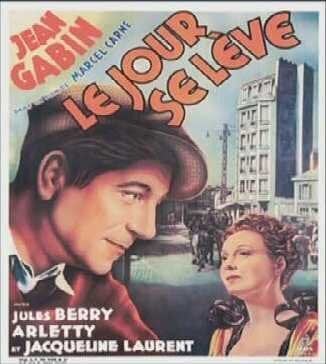
The film opens with a caption, one imposed by anxious producers, fearing that audiences would be baffled. It is a caption that sets up the concept of flashback: a man has taken a life; now he is locked in, besieged in a room, "... il évoque les circonstances qui ont fait de lui meurrier", that is, this man recalls or brings back the circumstances that led him to kill.
A flashback in cinema is something we take for granted. It had been a common enough trope in literature for millennia, found in Homer's Odyssey for example. But in the 1930s it was a relatively daring narrative strategy in cinema. Griffiths, as always, did it first , showing us a cradle rocking, then cutting to show what had gone before. But Le jour se lève set the bar for films to come: the narrative is almost entirely carried in flashback. The present is a sorry stale mate; past joys and hopes have come to nothing. And of course in 1938 Paris would soon be under Nazi occupation, the French army having capitulated without a fight. It is hard not to look at the film in this retrospective light: France is biding its time before the darkness of fascism and collaboration would blight national pride.
Le jour se lève was made by a team that had worked together before. Director Marcel Carné and designer Alexandre Trauner had already found success with Quai des brumes and Hôtel du Nord (both released in 1938), films that embody perfectly the term 'poetic realism': studio-bound, yet meticulously portraying the material conditions of the most humble denizens of society, dramatising the lives and crises of resigned and fatalistic low-class men and women, whose attitudes were forged in the Great Depression, and as the successes of the Front populaire fell into disarray by 1938, knew that capital would never surrender. In such a climate of disappointment and despair, love may blossom briefly but ultimately disappointment will reasserts itself, or perhaps even death. Bitterness is the prevailing attitude. Le jour se lève would be no different.
The film opens with a killing, the result of an altercation in a tall tenement building. A blind man finds the corpse on a staircase. The police arrive. Night falls and the police besiege the building where the killer and his gun, nursing disappointment, refusing to surrender. The scene is set. Flashbacks fill out the story, and we guess the end. The killer has been in love, but learned too late that he is naïve and sentimental fool, that life is a crooked path and he has been duped. Love is lost. The stale-mate is a tragic one: hopes and dreams are hollow ones. Manipulative and cynical opportunists hold all the cards. Love's brief blossoming will be all too brief.
Le jour se lève expresses all of this perfectly. And with a shudder we think of the historical moment of its making: the imminent fall of France, the demise of hope in Europe, and the death of millions in the not too distant future. The tall, oddly isolated tenement, rising like a tomb-stone from a poor district, Trauner's beautiful imagined set, is unforgettable. The police go about their business. They intend resolving this matter one way or another. The killer bides his time, waiting for daybreak, smoking his last pack of cigarettes.
This film, now 75 years old, has now been restored to the highest digital standard, having suffered from decay, censorship and bowdlerisation.
The sound is now as good as it can be, a revelation after copies with only variable density sound tracks that become distorted with even the slightest print damage and shrinkage - inevitability. I am most grateful for this. The music composed by Maurice Jaubert is now a joy to listen to.
The images, as is to be expected, have been stabilised and seem so very sharp. Where once the film seemed blurred because what we watched was a poor print from a poor inter-negative, now we see how the original negatives look - which, with frame by frame renovation, is very good indeed.
Moreover, the version we have known for so long is not quite as Carné and his team made it. Censors in France objected to Arletty's nudity as he stepped from the shower and so that was trimmed. The Police were portrayed as too rough and so that too was trimmed: authority must never be made to look uncaring! Censorship in the Third Republic was well established and cinema was of course subject to it. Films had to be made under the shadow of an official view that frowned on immorality, on demoralising depictions of working class life, or even on fatalistic narratives. Producers might even shoot different versions just in case the official censor frowned and asked for changes. No point in not anticipating such disapproval (such alternate versions are sometimes offered now as DVD 'extras').
It is also a sad fact is that anti-Semitism in France did not arrive with the Germans. The Dreyfus affair had come to an official close only in 1906, and with the rise of right wing ideology throughout Europe generally in the 1930s, and the identification by some of bolshevism as a Jewish conspiracy, anti-Semitism was an unashamed part of the DNA of the European nation states. The release of a film in 1939 would mean to release a film to coincide with Kristallnacht in Germany, to release a film in a France that had been a signatory to the Munich Agreement with Hitler.
For this reason, I am not surprised to read notes provided with the restoration by Studio Canal which say that two credits had needed to be restored to the front of the film, those of Curt Courant and Alexandre Trauner. I cannot recall if I ever missed them, but I do not disbelieve Studio Canal. For Curt Courant was a Jew from Germany, and Trauner was a Jew from Hungary. Both were supremely talented. Both were key figures in European cinema of the time. Courant was a cinematographer who had worked in Germany and Britain (he shot Hitchcock's The Man Who Knew Too Much for example), who fled that Nazis in Germany, finding his way to Paris to shoot Renoir's La bête humaine in 1938. As we have heard, Trauner worked intensively with Carné, even after he was obliged to go into hiding after the Nazi's arrived in Paris. The implication of the notes is that these credits were removed by Vichy apparatchiks, but I am not clear when and how - Vichy was created on in 1940, while the film was on release in 1938 and 1939. Terrible times.
It is a great day when a film such as this, a key and significant film, fruit of a wonderful golden passage in film-making history, is brought fully to light. It is a great day when credits expunged by the forces of darkness are restored to their proper place and talent be hailed as they should be. It is a great day when a film that should be seen is seen. The distribution and exhibition of this film is a chance for a new generation of cinephiles, cinema-goers and film-makers and writers to survive the night with Jean Gabin and wait for daybreak in the endlessly repeated tragedy that is Le jour se lève.
The restoration is on release in various cinemas in the UK from 3rd October 2014, and out on Blu-Ray and DVD from 27th October 2014.
Adam Roberts
